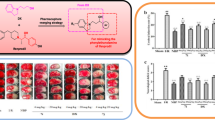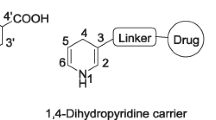Abstract
Stachydrine is a natural product with multiple protective biological activities, including those involved in preventing cancer, ischemia, and cardiovascular disease. However, its use has been limited by low bioavailability and unsatisfactory efficacy. To address this problem, a series of stachydrine derivatives (A1/A2/A3/A4/B1/B2/B3/B4) were designed and synthesized, and biological studies were carried out in vitro and in vivo. When compared with stachydrine, Compound B1 exhibited better neuroprotective effects in vitro, and significantly reduced infarction size in the model of the middle cerebral artery occlusion rat model. Therefore, Compound B1 was selected for further research on ischemic stroke.

Graphical abstract














Similar content being viewed by others
References
Aguilera P, Chánez-cárdenas ME, Ortiz-plata A et al (2010) Aged garlic extract delays the appearance of infarct area in a cerebral ischemia model, an effect likely conditioned by the cellular antioxidant systems. Phytomedicine. 17(3):241–247
Ahmed MA, ElMorsy EM, Ahmed AA (2014) Pomegranate extract protects against cerebral ischemia/reperfusion injury and preserves brain DNA integrity in rats. Life Sci 110(2):61–69
Alberts MJ (2017) Stroke treatment with intravenous tissue-type plasminogen activator. Circulation. 135(2):140–142
Berger C, Stauder A, Xia F, Sommer C, Schwab S (2008) Neuroprotection and glutamate attenuation by acetylsalicylic acid in temporary but not in permanent cerebral ischemia. Exp Neurol 210(2):543–548
Brainin M, Teuschl Y, Kalra L (2007) Acute treatment and long-term management of stroke in developing countries. Lancet Neurol 6(6):553–561
Campos F, Sobrino T, Ramos-Cabrer P et al (2012) Oxaloacetate: a novel neuroprotective for acute ischemic stroke. Int J Biochem Cell B 44(2):262–265
Chen WD, Mao XL, Huang XD (2007) Retrospective analysis of adverse reactions of edaravone. Chin J New Drugs Clin Rem 26(12):952–954
Chen H, Yoshioka H, Kim GS, Jung JE, Okami N, Sakata H, Maier CM, Narasimhan P, Goeders CE, Chan PH (2011) Oxidative stress in ischemic brain damage: mechanisms of cell death and potential molecular targets for neuroprotection. Antioxic Redox Sign 14(8):1505–1517
Denorme F, Langhauser F, Desender L, Vandenbulcke A, Rottensteiner H, Plaimauer B, François O, Andersson T, Deckmyn H, Scheiflinger F, Kleinschnitz C, Vanhoorelbeke K, de Meyer SF (2016) ADAMTS13-mediated thrombolysis of t-PA-resistant occlusions in ischemic stroke in mice. Blood. 127(19):2337–2345
Dergunova LV, Filippenkov IB, Stavchansky VV, Denisova AE, Yuzhakov VV, Mozerov SA, Gubsky LV, Limborska SA (2018) Genome-wide transcriptome analysis using RNA-Seq reveals a large number of differentially expressed genes in a transient MCAO rat model. BMC Genomics 19(1):655
El Kossi MMH, Zakhary MM (2000) Oxidative stress in the context of acute cerebrovascular stroke. Stroke. 31(8):1889–1892
Feng XD (2009) Pharmacokinetics of stachydrine in rabbits. China Pharm 12(12):1696–1697
Gao HS, Hu ZG, Wang JJ, Qiu ZF, Fan FQ (2008) Synthesis and properties of novel chiral ionic liquids from l-proline. Aust J Chem 61(7):521–525
Ghazavi H, Hoseini SJ, Ebrahimzadeh-Bideskan A, Mashkani B, Mehri S, Ghorbani A, Sadri K, Mahdipour E, Ghasemi F, Forouzanfar F, Hoseini A, Pasdar AR, Sadeghnia HR, Ghayour-Mobarhan M (2017) Fibroblast growth factor type 1 (FGF1)-overexpressed adipose-derived mesenchaymal stem cells (AD-MSCFGF1) induce neuroprotection and functional recovery in a rat stroke model. Stem Cell Rev Rep 13(5):670–685
Han ZJ, Wang R, Zhou YF et al (2005) Simple derivatives of natural amino acids as chiral ligands in the catalytic asymmetric addition of phenylacetylene to aldehydes. Eur J Org Chem 36(26):934–938
Hanscombe KB, Traylor M, Hysi PG, Bevan S, Dichgans M, Rothwell PM, Worrall BB, Seshadri S, Sudlow C, the METASTROKE Consortium, the Wellcome Trust Case Control Consortium 2, Williams FMK, Markus HS, Lewis CM (2015) Genetic factors influencing coagulation factor XIII B-subunit contribute to risk of ischemic stroke. Stroke. 46(8):2069–2074
Hishida A (2007) Clinical analysis of 207 patients who developed renal disorders during or after treatment with edaravone reported during post-marketing surveillance. Clin Exp Nephrol 11(4):292–296
Kasperowiczfrankowska KM (2014) Synthesis of chiral triazine coupling reagents based on esters of N-alkylproline and their application in the enantioselective incorporation d or l amino acid residue directly from racemic substrate. Acta Pol Pharm 71(6):994–1003
Kaur H, Prakash A, Medhi B (2013) Drug therapy in stroke: from preclinical to clinical studies. Pharmacology. 92(5–6):324–334
Kim Y, Kim YS, Kim HY, Noh MY, Kim JY, Lee YJ, Kim J, Park J, Kim SH (2018) Early treatment with poly(ADP-ribose) polymerase-1 inhibitor (JPI-289) reduces infarct volume and improves long-term behavior in an animal model of ischemic stroke. Mol Neurobiol 55(9):7153–7163
Li M, Cui F, Yang F et al (2017) Original article association between fiber intake and ischemic stroke risk: a meta-analysis of prospective studies. Int J Clin Exp Med 10(3):4659–4668
Longa EZ, Weinstein PR, Carlson S, Cummins R (1989) Reversible middle cerebral artery occlusion without craniectomy in rats. Stroke. 20(1):84–91
Loughlin WA, Schweiker SS, Jenkins ID, Henderson LC (2013) Synthesis and evaluation of C8-substituted 4.5-spiro lactams as glycogen phosphorylase an inhibitor. Tetrahedron. 69(5):1576–1582
Love S (1999) Oxidative stress in brain ischaemia. Brain Pathol 9:119–131
Ma N, Wei FQ, Guo JR et al (2017) Anti-tumor activity of stachydrine by inhibiting histone diacetylase enzyme in gastric cancer. Biomed Res 28(2):802–806
Reddy BS, Chary VN, Pavankumar P, Prabhakar S (2016) Characterization of N-methylated amino acids by GC-MS after ethyl chloroformate derivatization. J Mass Spectrom 51(8):638–650
Servillo L, D'Onofrio N, Longobardi L, Sirangelo I, Giovane A, Cautela D, Castaldo D, Giordano A, Balestrieri ML (2013) Stachydrine ameliorates high-glucose induced endothelial cell senescence and SIRT1 downregulation. J Cell Biochem 114(11):2522–2530
Snow SJ (2016) Stroke and t-PA-triggering new paradigms of care. N Engl J Med 374(9):809–811
Wang L, Liu H, Zhang L, Wang G, Zhang M, Yu Y (2017a) Neuroprotection of dexmedetomidine against cerebral ischemia-reperfusion injury in rats: involved in inhibition of NF-κB and inflammation response. Biomol Ther 25(4):383–389
Wang T, Miao MS, Lou X et al (2017b) The influence of stachydrine hydrochloride on the reperfusion model of mice with repetitive cerebral ischemia. Saudi J Biol Sci 24(3):658–663
Wang YJ, Huang Y, Xu Y, Ruan W, Wang H, Zhang Y, Saavedra JM, Zhang L, Huang Z, Pang T (2018) A dual AMPK/Nrf2 activator reduces brain inflammation after stroke by enhancing microglia M2 polarization. Antioxid Redox Signal 28(2):141–163
Warner DS, Sheng H, Haberle IB (2004) Oxidants, antioxidants and the ischemic brain. J Exp Biol 207(18):3221–3231
White BC, Sullivan JM, Degracia DJ et al (2000) Brain ischemia and reperfusion: molecular mechanisms of neuronal injury. J Neurol Sci 179(1):1–33
Zhang L, Zheng N, Ma C et al (2017) Stachydrine ameliorates the cerebral ischemia by inhibiting the activity of histone deacetylase in neonatal rats. Biomed Res 28(2):973–977
Zhou BS, Bu GY, Li M, Chang BG, Zhou YP (2014) Tagging SNPs in the MTHFR gene and risk of ischemic stroke in a Chinese population. Int J Mol Sci 15(5):8931–8940
Funding
This study was funded by the “Zhufeng Scholar Program” of the Ocean University of China (841412016), the “Major Projects of Independent Innovation” of Qingdao (15-4-13-zdzx-hy), the “Outstanding Talents Plan” of Qingdao (15-10-3-15-(34)-zch), and the Aoshan Talents Training Program of Qingdao National Laboratory for Marine Science and Technology (No. 2017ASTCP-OS08) to Dr. Wenbao Li.
Author information
Authors and Affiliations
Contributions
Wenbao Li and Feng Li conceived and designed research. Liang Zhang, Chenhui Hou, and Sifeng Zhu conducted experiments. Lili Zhong, Jianchun Zhao, and Cai Song made contribution in ex vivo and in vivo studies. Liang Zhang and Chenhui Hou analyzed data. Liang Zhang wrote the manuscript. All authors read and approved the manuscript. We explicitly state that the data were generated in-house, and we did not use a paper mill.
Corresponding authors
Ethics declarations
Conflict of interest
The authors declare that they have no conflict of interest.
Additional information
Publisher’s note
Springer Nature remains neutral with regard to jurisdictional claims in published maps and institutional affiliations.
Rights and permissions
About this article
Cite this article
Zhang, L., Li, F., Hou, C. et al. Design, synthesis, and biological evaluation of novel stachydrine derivatives as potent neuroprotective agents for cerebral ischemic stroke. Naunyn-Schmiedeberg's Arch Pharmacol 393, 2529–2542 (2020). https://doi.org/10.1007/s00210-020-01868-4
Received:
Accepted:
Published:
Issue Date:
DOI: https://doi.org/10.1007/s00210-020-01868-4




